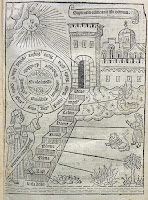 This striking woodcut is found in the 1512 edition of Ramon Llull’s Liber de ascensu et descensu intellectus (Book on the Ascent and Descent of Understanding, written ca. 1305) that was printed in Valencia. It represents the “Ladder of Understanding” (scala intellectus) that Llull elaborates in this work. The particulars of Llull’s system are abstruse, but behind them lies the assumption that humans can, using their senses and intellect, understand the links between the created world and divine reality (Note: A full transcription and translation of the words found in this woodcut can be found at the bottom of this post).
This striking woodcut is found in the 1512 edition of Ramon Llull’s Liber de ascensu et descensu intellectus (Book on the Ascent and Descent of Understanding, written ca. 1305) that was printed in Valencia. It represents the “Ladder of Understanding” (scala intellectus) that Llull elaborates in this work. The particulars of Llull’s system are abstruse, but behind them lies the assumption that humans can, using their senses and intellect, understand the links between the created world and divine reality (Note: A full transcription and translation of the words found in this woodcut can be found at the bottom of this post).The extraordinary Ramon Llull (c. 1232 - c. 1315) was born in Majorca. By his own account, he lived as a licentious troubadour before a series of visions convinced him to abandon his worldly life to serve God. Llull was particularly inspired to convert Muslims. He learned Arabic and deepened his knowledge of philosophy and other branches of knowledge.
It was on a mountain, the story goes, that God once again inspired him to write a book that would convert non-believers. “[Llull] came down from the mountain and … began to plan and write the book in question, calling it at first the Ars major, and later on the Ars generalis. Within the framework of this Art he then wrote many books … in which at great length he explained general principles by applying them to more specific things.” (Ramon Lull, A Contemporary Life, ed. And trans. Anthony Bonner (Barcelona / Woodbrige 2010).
This little book is one of the many expressions of Llull’s Art (largely logical in nature) – he wrote over one hundred works, including novels to alchemical works. His logical works, however, have sometimes earned him the status of pioneer in computational theory.
Description of the Woodcut:
There are three ladders depicted in the woodcut. The professor (bottom left), with a banderole that reads “Combined understanding,” has one foot placed upon the bottom step of the first ladder, and points to it with his right hand. With his left hand, he holds up the second and third ladders (the two concentric circles).
The first ladder:
Stepping from the bottom to the top, our intellect ascends (in understanding) first through stone, then fire, the plants, then animals, then man, then the heavens, the angels and, finally, God. The hierarchy is clear: the stone is most simple, and God is most complex.
The second and third ladders:
To understand the properties each of the steps on the first ladder, the professor holds up the second and third ladders (the two concentric circles), each subdivided into “steps” with words.
It is perhaps easiest to understand these words as forming a conceptual rubric through which one can classify the properties belonging to a created thing. A stone, for example, might be classified as “cold, inert, passive,” and so on. Using the conceptual rubric of the second and third ladders, one can range up and down the first ladder. Without using the proper concepts, Llull says, the intellect is ineffective in understanding.
If we use the Llull’s Ladder of Understanding, we can enjoy serene contemplation in the Mansion that Wisdom Built for Herself (Sapientia edificavit sibi domum).
Llull’s conception of a chain linking the simple to the complex is not unique to him. See Great Chain of Being. To see our copy of Llull's Liber, come to Special Collections and ask to see Rare Book PA8360.L93 D4 1512.
This post was written by Daniel Abosso, Research & Learning Librarian for Humanities.
*****
No comments :
Post a Comment